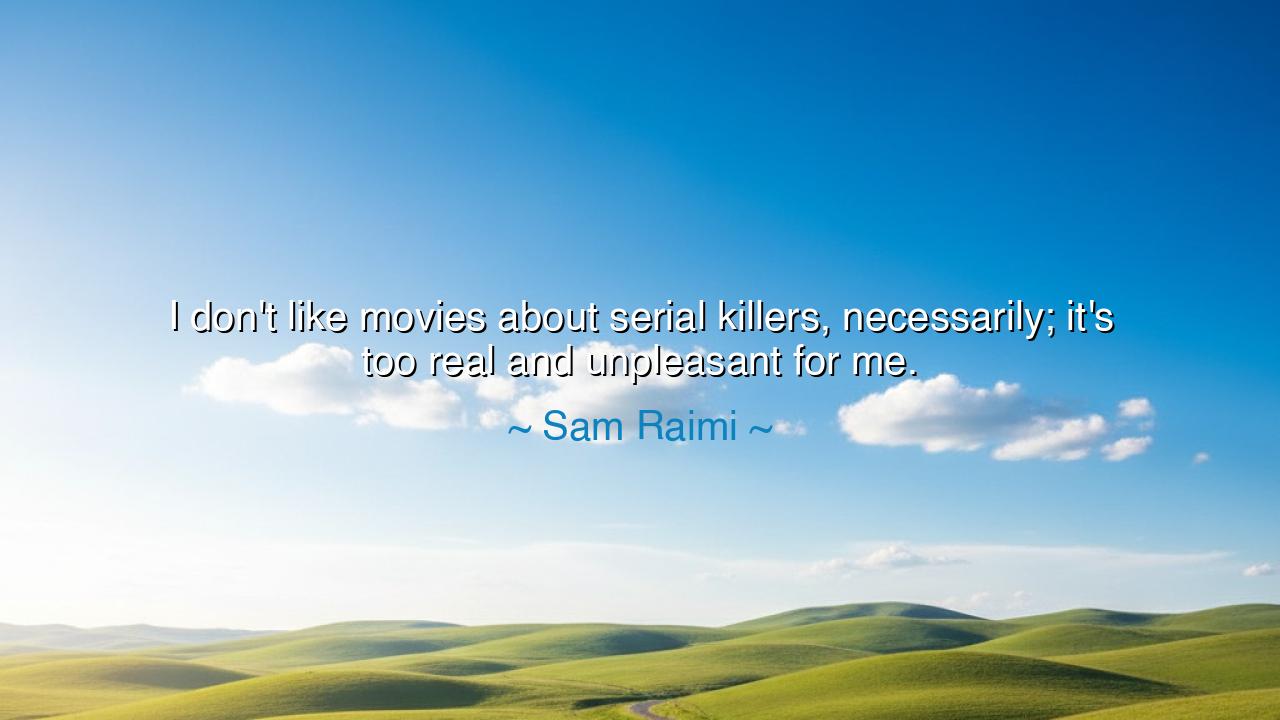
I don't like movies about serial killers, necessarily; it's too
I don't like movies about serial killers, necessarily; it's too real and unpleasant for me.






In the grand story of humanity, there are moments when we must confront the darker aspects of our nature, but there are also times when the light of imagination and hope must guide us. Sam Raimi, in his reflection on the genre of films about serial killers, reveals a deep truth about the human spirit when he says, "I don't like movies about serial killers, necessarily; it's too real and unpleasant for me." In these words, Raimi speaks to the discomfort that arises when art plunges too deeply into the gritty and disturbing realities of human evil. There is a line between the dark truths of the world and the creative freedom that allows art to uplift, inspire, and offer a reprieve from the harshness of life.
Throughout the ages, ancient wisdom has spoken to the need for balance in life—between the light and the dark, the beautiful and the ugly. Consider Plato, who spoke of the Cave in his famous allegory, where prisoners are confined to staring at shadows on the wall, believing them to be reality. To dwell only on the shadows—those parts of the world that are unpleasant, cruel, or fearful—would be to live in ignorance. Plato believed that the true philosopher, the true artist, must break free from these confines and seek the light—the truth that transcends the darkness, the beauty that exists beyond the shadows. Raimi’s words reflect this ancient ideal, recognizing that while reality can be harsh, art should elevate rather than simply reflect the most disturbing aspects of human existence.
In the ancient world, the tragedy and suffering of life were often explored in the theater, but it was understood that such portrayals were meant to educate and cathartic release, not simply to dwell in despair. The Greek tragedies, for instance, though filled with horror and fate, were not merely about the human tendency toward evil and destruction; they were about understanding the nature of suffering and finding ways to endure it. Sophocles, through his works like Oedipus Rex, depicted the darkness of fate and the consequences of human error, but his characters were not defined by their worst moments—they were shown as flawed but ultimately human. Similarly, Raimi’s discomfort with films about serial killers reflects the deep wisdom of the ancients: that while we must confront reality, we should also seek to rise above it, finding in our art not just the ugly, but also the redemptive and the beautiful.
There is a universal truth in Raimi’s statement: to constantly stare into the abyss of human depravity is to risk being consumed by it. Homer’s Odyssey speaks to this when Odysseus, in his journey home, must navigate dangerous waters and face monsters like the Cyclops and the Sirens—representations of the dark forces that threaten to derail him. But Odysseus also understood the need for balance; he was not to be consumed by his struggles with the forces of darkness, but to focus on the journey and the greater purpose. The hero does not fixate on the horrors he encounters but on the goal of returning home. In the same way, Raimi’s reluctance to dwell on films about serial killers reflects a desire to focus on the journey of art, not just the darkness that exists within human nature.
The ancients also believed in the power of art to heal, to elevate the soul, and to teach us the best of what it means to be human. The ancient Greeks valued comedy as much as tragedy, for comedy provided the balance needed to lift the soul from the weight of sorrow. Even in times of darkness, laughter, hope, and joy were seen as essential parts of the human experience. By creating works of light, we allow the soul to breathe and regenerate, to find in art not just a mirror of the world but a refuge from it. Raimi’s art—often rooted in the horror genre—is not just a reflection of fear and violence, but also an exploration of how we confront these emotions, often with courage and wit. It is through such balance that we, as individuals, can remain connected to the light while acknowledging the darkness.
Raimi’s words also serve as a reminder that the true purpose of art is not just to reproduce the world as it is but to interpret it in ways that transcend the mundane and the ugly. Art is a force—a powerful tool for change and understanding. It holds the potential to reveal deeper truths, to offer insight, and to help us navigate the most difficult aspects of our nature. But it must be used wisely, not simply as a means of dwelling in misery or fear, but as a vehicle for transformation. Whether through horror, comedy, or drama, art must be a catalyst for growth, not just a reflection of the worst in humanity.
In your own life, remember the lesson that Raimi’s words impart: balance is key. While it is important to acknowledge the darkness and the harsh realities of the world, do not become consumed by them. Like the ancient artists and thinkers, seek not to dwell solely on what is unpleasant, but to use the full spectrum of life—its light and its dark—to create, grow, and understand. Use your art, your words, and your actions to inspire, heal, and guide, not just to reflect the brokenness of the world but to help us rise above it. May you walk through life with the wisdom of the ancients, knowing that in embracing both light and shadow, you will find your greatest strength and purpose.






AAdministratorAdministrator
Welcome, honored guests. Please leave a comment, we will respond soon